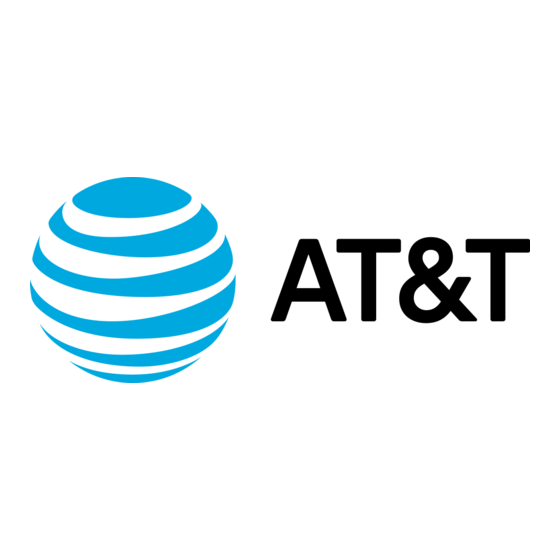
Table of Contents
Advertisement
Quick Links
Advertisement
Table of Contents

Summary of Contents for AT&T callmaster
- Page 1 AT&T ® CALLMASTER Digital Voice Terminal User's Guide...
- Page 2 NOTICE While reasonable efforts were made to ensure that the information in this document was complete and accurate at the time of printing, AT&T can assume no responsibility for any errors. Changes or corrections to the information contained in this document may be incorporated into future issues.
-
Page 3: Table Of Contents
Contents Your CALLMASTER Digital Voice Termial Recorder Interface Module Conventions Used in This Guide Organization of This Guide Physical Description Call-Processing Area Dial Pad Conference, Transfer, Drop, and Hold Message Light Display Area Alphanumeric Display Display Contrast-Control Wheel Double-Light Call-Appearance and Feature Buttons... -
Page 4: Your Callmaster Digital Voice Termial
Your CALLMASTER voice terminal is either a model 602D1 or a model 602A1. The model number is printed on a sticker located on the bottom of the voice terminal. -
Page 5: Conventions Used In This Guide
Physical Description — Describes the physical characteristics of the CALLMASTER digital voice terminal. Feature — Explains how to use the fixed-feature buttons. References — Lists available documents that are related to the CALLMASTER digital voice terminal and that may be useful as background or reference information. -
Page 6: Physical Description
Physical Description The functional areas of the CALLMASTER digital voice terminal are shown in Figure 2 and described on the following pages. Figure 2. CALLMASTER Digital Voice Terminal Functional Areas Call-Processing Area As shown in Figure 3, this area contains the following:... -
Page 7: Display Area
Figure 3. Call-Processing Area Display Area As shown in Figure 4, this area contains an alphanumeric display and a display contrast-control wheel. The 2-line, 40-character-per-line, alphanumeric display shows call- and system-related information, including incoming and outgoing calls. The person who manages your system may assign several display-mode buttons to your voice terminal. -
Page 8: Double-Light Call-Appearance And Feature Buttons
Figure 4. Display Area Double-Light Call-Appearance and Feature Buttons The 10 buttons shown in Figure 5 can be administered by the person who manages your system for use as call appearances or for feature activation and deactivation. Each button has a label, a red light and a green light. Figure 5. -
Page 9: Single-Light Feature Buttons
Single-Light Feature Buttons The 18 buttons shown in Figure 6 are arranged in 3 columns of 6 buttons. Each button has a label and a green light. The last button in the first column is preprogrammed as the [ ] button. You can use the [ ] button when you are active on a call and Mute Mute... -
Page 10: Front Panel
Front Panel As shown in Figure 7, the front panel drops down to reveal: Follow these instructions to remove or insert button-label Instructions for strips for call-appearance and feature buttons. (These strips button-label strips will probably be labeled for you. However, if they are not, or if you need to change a label, you can remove the strips and write or type on them.) Use to test the lights, ringer, and display. -
Page 11: Side And Back Of The Terminal
Sides and Back of the Terminal One side and the back of the terminal are shown in Figure 8. Each side of the terminal contains a headset jack and a screw hole. A headset or handset (with special adapters) can be plugged Side jacks into the jacks on each side of the terminal. -
Page 12: Bottom Of The Terminal
Bottom of the Terminal As shown in Figure 9, a line jack is located on the bottom of the terminal. The line jack is used to connect the voice terminal to a wall telephone jack. Figure 9. Bottom of the Terminal... -
Page 13: Features
Features Many features are available for use with your CALLMASTER voice terminal. Because no organization can use all of the available features, each organization must choose those that best suit its needs. After the choices have been made, the person within your organization who manages your telecommunication system must do any necessary administration and label the feature buttons on individual voice terminals. -
Page 14: Drop
To add a call you have Press [ Conference put on hold to another Green light at held call appearance continues to call you are connected flutter Green light at current call appearance also flutters You are given a new call appearance and hear dial tone Press ... -
Page 15: Hold
Hold 1 Press [ To put a call on hold Hold while you answer Green light at held call appearance flutters another call, place a Note: If you put a conference call on hold, the other call, or perform some parties remain connected. -
Page 16: Transfer
Transfer Note: Only calls from another extension can be sent to To send an existing call an outside number. You cannot transfer a call from an to another extension or outside number to another outside number. outside number 1 Press [ Transfer Green light at call appearance flutters Present call is put on hold... -
Page 17: References
References AT&T System 85 CALLMASTER™ Digital Voice Terminal — Application Notes (555- 103-523) AT&T System 75 CALLMASTER™ Digital Voice Terminal — Application Notes (555- 103-253) AT&T DEFINITY™ Generic 2 and System 85 Automatic Call Distribution Supervisor Instructions (555 104 714) AT&T System 75 Automatic Call Distribution Supervisor Instructions (555-200-724) - Page 18 555-015-716 Issue 4, February 1991 Graphics © 1988 AT&T...


Need help?
Do you have a question about the callmaster and is the answer not in the manual?
Questions and answers